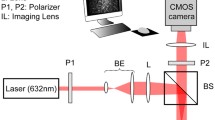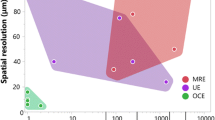Abstract
Quantification of the physical properties of tissue biopsies and cell-remodeled hydrogels is critical for understanding tissue development and pathophysiological tissue remodeling. However, due to the low modulus, small size, irregular shape, and anisotropy of samples from these materials, accurate viscoelastic characterization using standard rheometric methods is problematic. The goal of this work is to utilize image analysis to extend rotational rheometry to these samples. In this method, the sample is offset to increase the torque generated; a custom clear glass geometry, right angle prism, and camera are used to determine the exact shape and location of the sample relative to the axis of rotation for calculation of the sample shear modulus, G′. Values of G′ for standard polydimethylsiloxane gels tested in centered and eccentric configurations were not statistically different (respectively 137 ± 37 kPa and 126 ± 8 kPa, p = 0.58), indicating accuracy of the method. Additionally, G′ values from circular and irregularly shaped collagen gels yielded equivalent results (31 ± 1.8 Pa and 31 ± 5.1 Pa, p = 0.29). A blood clot and a lipid plaque sample recovered from human patients (G′ ~ 4 kPa) were successfully tested with this method demonstrating applicability to clinical diagnostics.




Similar content being viewed by others
References
Cameron, A. R., J. E. Frith, and J. J. Cooper-White. The influence of substrate creep on mesenchymal stem cell behaviour and phenotype. Biomaterials 32:5979–5993, 2011.
Chueh, J. Y., A. K. Wakhloo, G. H. Hendricks, C. F. Silva, J. P. Weaver, and M. J. Gounis. Mechanical characterization of thromboemboli in acute ischemic stroke and laboratory embolus analogs. AJNR Am. J. Neuroradiol. 32:1237–1244, 2011.
Engler, A. J., S. Sen, H. L. Sweeney, and D. E. Discher. Matrix elasticity directs stem cell lineage specification. Cell 126:677–689, 2006.
Forgacs, G., S. A. Newman, B. Hinner, C. W. Maier, and E. Sackmann. Assembly of collagen matrices as a phase transition revealed by structural and rheologic studies. Biophys. J. 84:1272–1280, 2003.
Grinnell, F., and W. M. Petroll. Cell motility and mechanics in three-dimensional collagen matrices. Annu. Rev. Cell Dev. Biol. 26:335–361, 2010.
Holt, B., A. Tripathi, and J. Morgan. Viscoelastic response of human skin to low magnitude physiologically relevant shear. J. Biomech. 41:2689–2695, 2008.
Hrapko, M., J. A. van Dommelen, G. W. Peters, and J. S. Wismans. Characterisation of the mechanical behaviour of brain tissue in compression and shear. Biorheology 45:663–676, 2008.
Hsu, H. J., C. F. Lee, and R. Kaunas. A dynamic stochastic model of frequency-dependent stress fiber alignment induced by cyclic stretch. PLoS ONE 4(3):e4853, 2009.
Janmey, P. A., and R. T. Miller. Mechanisms of mechanical signaling in development and disease. J. Cell Sci. 124:9–18, 2011.
Kang, H., Q. Wen, P. A. Janmey, J. X. Tang, E. Conti, and F. C. MacKintosh. Nonlinear elasticity of stiff filament networks: strain stiffening, negative normal stress, and filament alignment in fibrin gels. J. Phys. Chem. B 113:3799–3805, 2009.
Kloxin, A. M., C. J. Kloxin, C. N. Bowman, and K. S. Anseth. Mechanical properties of cellularly responsive hydrogels and their experimental determination. Adv. Mater. 22:3484–3494, 2010.
Latinovic, O., L. A. Hough, and H. Daniel Ou-Yang. Structural and micromechanical characterization of type I collagen gels. J. Biomech. 43:500–505, 2010.
Leung, L. Y., D. Tian, C. P. Brangwynne, D. A. Weitz, and D. J. Tschumperlin. A new microrheometric approach reveals individual and cooperative roles for tgf-beta1 and il-1beta in fibroblast-mediated stiffening of collagen gels. FASEB J. 21:2064–2073, 2007.
Levental, K. R., H. Yu, L. Kass, J. N. Lakins, M. Egeblad, J. T. Erler, S. F. Fong, K. Csiszar, A. Giaccia, W. Weninger, M. Yamauchi, D. L. Gasser, and V. M. Weaver. Matrix crosslinking forces tumor progression by enhancing integrin signaling. Cell 139:891–906, 2009.
Parekh, A., and D. Velegol. Collagen gel anisotropy measured by 2-d laser trap microrheometry. Ann. Biomed. Eng. 35:1231–1246, 2007.
Pedersen, J. A., and M. A. Swartz. Mechanobiology in the third dimension. Ann. Biomed. Eng. 33:1469–1490, 2005.
Phan-Thien, N., S. Nasseri, and L. E. Bilston. Viscoelastic properties of pig kidney in shear, experimental results and modelling. Rheologica Acta 41:180–192, 2002.
Raub, C. B., J. Unruh, V. Suresh, T. Krasieva, T. Lindmo, E. Gratton, B. J. Tromberg, and S. C. George. Image correlation spectroscopy of multiphoton images correlates with collagen mechanical properties. Biophys. J. 94:2361–2373, 2008.
Roeder, B. A., K. Kokini, J. E. Sturgis, J. P. Robinson, and S. L. Voytik-Harbin. Tensile mechanical properties of three-dimensional type I collagen extracellular matrices with varied microstructure. J. Biomech. Eng. 124:214–222, 2002.
van Turnhout, M., G. Peters, A. Stekelenburg, and C. Oomens. Passive transverse mechanical properties as a function of temperature of rat skeletal muscle in vitro. Biorheology 42:193–207, 2005.
Wu, C. C., S. J. Ding, Y. H. Wang, M. J. Tang, and H. C. Chang. Mechanical properties of collagen gels derived from rats of different ages. J. Biomater. Sci. Polym. E 16:1261–1275, 2005.
Acknowledgments
The authors would like to thank Tom Jones for aid in rheological measurements and machining; Adriana Hera, John Meklenburg, and John Favreau for assistance with the Matlab code; Matthew Gounis, Ph.D., and Juyu Chueh (University of Massachusetts Medical School) for model thrombus and human plaque samples. This research was supported in part by NIH grant 1R15HL087257-01A2 to K.L.B.
Author information
Authors and Affiliations
Corresponding author
Additional information
Associate Editor Jane Grande-Allen oversaw the review of this article.
Appendices
Appendix A: Integral Derivation for a Circular Sample
The following is a derivation for torque for an offset circular sample. It is represent by a small circle of radius r s, inside a larger circle of radius R g offset a distance, d, from the axis of rotation, so that it lies along the edge of the larger circle. In the following equations, ρ is the distance from the axis of rotation to an incremental area dA, G is the elastic modulus, T is the torque, h is the gap height between the peltier plate and bottom surface of the geometry. Integrating over domain D which is a circle of radius r s centered at x = R g − r s (=d) and y = 0
Integration in Cartesian coordinates gives:
Equation (1) from text becomes
Symmetry about x-axis allows for doubling of the integration over top of disc:
Integration of Eq. (A4) with respect to y gives:
Let \( V = \frac{x}{{r_{\rm s} }} - \left( {\frac{{R_{\rm g} }}{{r_{\rm s} }} - 1} \right) \) and \( dV = \frac{1}{{r_{\rm s} }}{{d}}x.\)
Substitution of terms in Eq. (A6) gives:
Expanding and collecting terms gives:
With further expansion, Eq. (A8) becomes:
Which, upon integration yields:
Let r s = r, d = R g − r s, then \( \frac{{R_{\rm g} }}{{r_{\rm s} }} - 1 = \frac{{R_{\rm g} - r_{\rm s} }}{{r_{\rm s} }} = \frac{d}{r}. \)
Rewriting Eq. (A10) with the following substitutions gives:
Multiplying and combining constants in Eq. (A11) gives:
Simplification of Eq. (A12) gives:
Equation (A13) is equivalent to Eq. (8) in text.
Appendix B: Error Analysis
To estimate the error associated with image analysis, the derivative of the equation for b(=J rheo/J sample) was used:
For a theoretical perfectly circular sample of radius r s at an offset, d, with J s = πr 4s + d 2πr 2s (Eq. (8)), and J rheo given by Eq. (6) with R = R g, the relative error is given by:
Repeated manual measurements on actual images of circular samples yielded 1% error for δR g/R g, δr s/r s, and δd/d (e.g., ±1 pixel for a 100 pixel distance). Eq. (B2) shows that the error associated with the image analysis depends upon the size of the sample and the degree of offset; it also highlights the impact of having the polar moment of inertia dependent upon the square of the offset and 4th power of the radii. For example, for a sample of radius 7.5 mm and offset 24.5 mm (at the edge), with 1% error for R g, r s, and d, the total error is 4.90%, whereas if it were offset to only 12.5 mm, the total error is 4.92%. For the smallest sample tested (radius 2 mm with offset 30 mm (at the edge)), the error is 4.9%. However, for the first case (r s = 7.5 mm and d = 24.5 mm) with δr s/r s = 2%, the total error in the rises to 6.09%. These hypothetical cases indicate that the error is ~5% for representative circular samples, and that the sample dimensions and location have very little impact on the overall error, whereas the measurement error for each variable (i.e., δr s/r s) has a large impact on the total error.
In the actual implementation, J rheo is calculated from R g which is estimated from 5 points and fit to equation of a circle in MATLAB, and J s is numerically calculated (r s and d are not applicable for non-circular samples), thus the following equation is used:
When analyzed repeatedly for different images by two separate users, we found δR g/R g = 1.6%. Although J s is calculated in an automated fashion, variability associated with measurement of J s could arise from camera focus and aperture, lighting, prism alignment, and the filtering and threshold used to determine the sample boundaries. With proper focus and light levels, even lighting using a ring flash, appropriate filtering and threshold setting, and automated perimeter selection, analysis of multiple independent images taken of the same sample after systematic readjustment over the widest applicable range of camera settings and prism placement yielded 0.99% error in J s. The combined estimated error due to image analysis using δR g/R g = 1.6% and δJ s/J s = 0.99% is 3.3% for the correction multiplier, b.
Rights and permissions
About this article
Cite this article
Cirka, H.A., Koehler, S.A., Farr, W.W. et al. Eccentric Rheometry for Viscoelastic Characterization of Small, Soft, Anisotropic, and Irregularly Shaped Biopolymer Gels and Tissue Biopsies. Ann Biomed Eng 40, 1654–1665 (2012). https://doi.org/10.1007/s10439-012-0532-5
Received:
Accepted:
Published:
Issue Date:
DOI: https://doi.org/10.1007/s10439-012-0532-5




